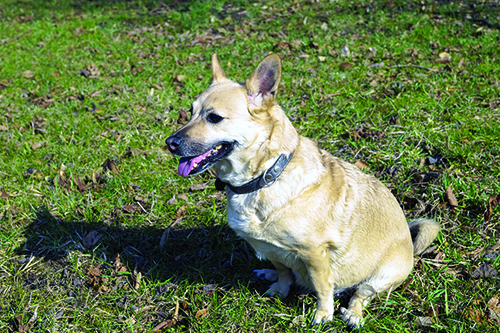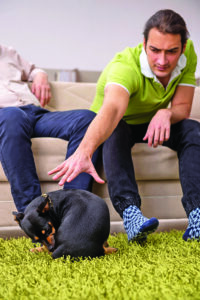
When you see a dog “scoot” on his behind, wiping his bum on the rug or lawn, do you think, “Gee, that looks like fun!”? No! The first thing you think is, “Oh dear, he must be uncomfortable!”
Why do dogs scoot? And what can we do to help them?
Most often, when dogs scoot, they are trying to relieve the pressure and discomfort that comes from overly full anal glands.
What’s in a dog’s anal gland sac?
The anal glands are two sacs that sit within the anal sphincter muscle. If you consider the dog’s anus as a clock face, the position of the glands are approximately 4:00 and 8:00.
Observing the fact that dogs routinely sniff each other’s butts when greeting, animal behavior experts speculate that the anal glands play a role in canine socializing. But today, as dogs serve mostly as companions to humans and live in our society, the glands appear to serve no purpose other than to annoy your dog and you!
Some dogs never have any trouble with their anal glands. When these dogs have a bowel movement, the passing stool presses on the anal glands and discharges some of the fluid from the glands, thus keeping the glands in a comfortable, not overfull condition.
What happens when a dog has impacted or full anal glands?
Problems arise when a dog’s anal glands do not achieve any emptying with bowel movements. The gland secretions continue to accumulate with no outlet. When the glands reach an uncomfortable pressure, the dog will scoot along on the ground, trying to relieve the pressure. Many dogs will lick incessantly at the anus with the same goal. When some dogs’ glands are overly full, the owner will periodically smell a foul, sometimes fishy odor emanating from the fluid that leaks from the anal glands.
To make these dogs comfortable, the anal glands must be manually expressed. An anal gland expression is typically provided by your veterinarian, a licensed veterinary technician, or a skilled groomer.
With a gloved and lubricated hand, pressure is applied to the glands, until the secretions are expelled through the ducts that have openings in the anus. This can sometimes be achieved completely externally, depending on the position of the gland and the angle of its duct.
When this is not possible, the index finger is inserted into the rectum, and the gland is squeezed between the index finger internally and the thumb externally. Normal anal gland secretions are liquid to pudding-like consistency and range in color from beige to gray or brown.
How often a dog needs his anal glands expressed varies. Once a month is not uncommon. Owners typically wait until their dog starts scooting again, then schedule anal gland expression. This can get expensive, especially if done with your veterinarian.
How to express your dog’s anal glands at home
If you are up for the challenge, you can ask your veterinarian to teach you how to express anal glands at home yourself. This would save you a lot of time and money. I have taught a few dog owners how to do this over the years. Not surprisingly, most of them keep coming in for anal gland expression. I mean, let’s face it, it’s not a pleasant job!
Check with your vet about symptoms of anal gland problems

Photo Credit: Elnur/ Dreamstime.com
Disease states associated with the anal glands include impaction, infection, abscesses, and tumors. Impacted anal glands get filled with dry, hard material that is difficult to manually express. Sometimes several days of warm sitz baths are necessary to loosen up the impacted material enough to allow expression. For this, partially fill a tub with warm water and have your dog sit with his or her anus submerged for 10 minutes, two to three times daily.
It’s important to express impacted anal glands as these are likely to abscess. Anal gland abscesses occur when the gland gets infected and fills with pus. This condition typically appears as a hot, red, painful swelling next to the anus that breaks open and drains through the skin.
Treatment for an anal gland abscess includes warm sitz baths, oral antibiotics, pain medication, and medical-progress exams with your veterinarian.
Anal gland infections that haven’t been abscessed yet are usually identified during expression. Infected anal gland secretions are often green in color and sometimes bloody. For this condition, your veterinarian will insert a tiny cannula into the anal gland duct, flush the gland with saline and/or an antiseptic, and inject an antibiotic ointment into the gland. Warm sitz baths and oral antibiotics are important for this condition, too.
Anal gland tumors are typically discovered during the process of expressing the anal glands. When found, surgical removal of the affected gland and tumor is recommended. Some anal gland tumors are benign and surgery is curative. Unfortunately, malignant tumors carry a guarded prognosis for long-term survival.
You may ask, why not just have the potentially problematic glands surgically removed? Surgical removal of normal anal glands is generally not recommended. This would be an elective procedure – more for convenience than medical need –and there are risks associated with the procedure, including permanent fecal incontinence.
Try adding high fiber dog food for anal gland problems
The best way to try to help your dog avoid anal gland issues, and to minimize the necessity of manual anal gland expression, is to add fiber to your dog’s diet. The idea is that the increased fiber will bulk up your dog’s bowel movements, making them bigger and thus more likely to put pressure on the anal glands, releasing secretions on their way by.
The easiest ways to add fiber to your dog’s diet is with psyllium powder (like Metamucil) or canned pumpkin. For more information on psyllium powder, check out “Metamucil for Dogs“. For small dogs, appropriate amounts would be ¼ teaspoon (tsp) Metamucil or 1 heaping tsp canned pumpkin per meal; for medium dogs, ½ tsp Metamucil or 1 heaping tablespoon (tbsp) canned pumpkin per meal; and for larger dogs, ¾ tsp Metamucil or 2 heaping tbsp canned pumpkin per meal.
Dietary fiber will help some dogs. For others, keeping up with manual anal gland expression as needed is the only way to keep them comfortable.





My dog often scoots and licks his anal area, but it’s due to allergies, not overfull anal glands. OTC allergy medication (e.g., Claritin) dosed according to my vet’s directions, have provided a lot of relief.
Agreed. For years I thought my Corgi’s had gland issues but she had allergies. Started her on Apoquel but quickly switched her over to Cytopoint and Hydroxyzine after my ACD (who had been on Apoquel for at least 6 month) developed Lymphoma, a “possible” side effect from the Apoquel. Stopped the scooting immediately.
I have had many dogs over the course of decades and all have been adopted from shelters and rescue organizations. I swear, three-quarters of them have had anal gland problems. When I adopted my latest last November, the staff at the vet office had a big laugh because he also came with anal gland problems. I mean, what are the odds that the majority of my dogs–all different sizes and flavors–have suffered from the same thing?? As Dr. Fatcheric mentions, I happily pay the vet techs to do the unpleasant job every month.
My American cocker was scooting and even crying as she did so. Frequent vet visits were finding often little drainage to remove yet she scooted.
Her allergy medication Apoquel was changed to Cytopoint and all scooting IMMEDIATELY stopped. Dramatic change.
Totally disagree with the tone of this article, and can be summed up as expressed in one sentence: ”To make these dogs comfortable, the anal glands must be manually expressed.” No, there is no ”must” at all!
This is a far more complex topic, as anything to do with health would be. And, in our society, the health of dogs is a severely misunderstood issue.
Also, the recommendation that the consumption of fiber being one’s friend is wrong! That this issue could be one of the dog’s diet, yes true!
Brought on by kibble? Oh yeah, most likely.
And hopefully nothing else, but that’s a different story, if we are going to talk about illness or disease.
I like your comment very much and agree with everything you say. A lot of the comments here mention that scooting in their dogs was due to allergies, yet this article doesn’t even mention that possibility.
Agree!
The powdered Glandex product definitely ‘Boots the Scoot’ as advertised. Within days of adopting a 12-year-old female black lab, she started scooting. I took her to the vet to have her glands expressed and at $20 it lasted only a week and she was scooting again. I took to the Internet and purchased powdered Glandex and she stopped scooting completely within a few weeks. After a year and a half of adding the product daily to her meals she doesn’t need Glandex anymore because now she doesn’t scoot without it. Yay!
Absolutely agree, though we give our dogs 1 soft Glandex treat a day instead of powder. They’ve never had a scoot problem as a result.
Can I buy Glandex treats in Ontario Canada?
I didn’t know you could give your dog Metamucil until i ask my dogs vet, she said yes i could give it to my dog and no more scooting for my little girl, i’m so happy.